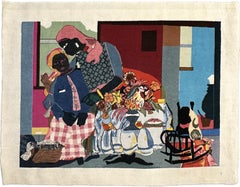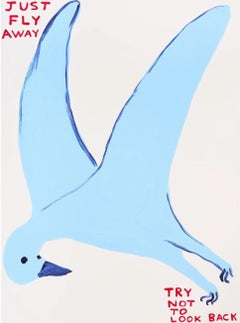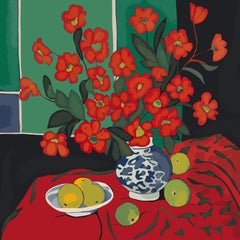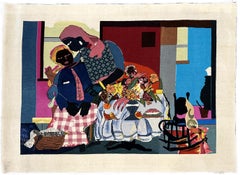Romare Bearden More Art
Romare Bearden was an inventive American modern artist whose unique visual style set him apart. Working with a variety of media, Bearden made paintings distinguished by a bold use of color and rich texture. His figurative, landscape and portrait prints had influences ranging from Henri Matisse and Pablo Picasso to traditional Japanese, Chinese and African art.
Bearden was born in Charlotte, North Carolina, in 1911. He pursued a degree in education and attended Lincoln University, Boston University and New York University. At New York University he began taking courses in art. During his time there, he served as the art editor and lead cartoonist at a journal called The Medley. To further his creative passions, Bearden attended the Art Students League of New York. From 1935 to 1937, he was the editorial cartoonist for the Baltimore Afro-American.
Bearden worked as a social worker from the mid-1930s until the 1960s. He continued creating art during his evenings and weekends and began exhibiting in solo shows across the United States in the 1940s. Bearden would go on to exhibit throughout Europe.
Bearden was a prolific writer on social issues, and his words complemented his art. He was active in African American advocacy groups and helped found important community art venues and organizations like the Harlem Cultural Council in 1964 and the Studio Museum in Harlem in 1968. He also published books on art and African American art history.
Bearden earned many prestigious honors, including honorary doctorates from Davidson College, Atlanta University, Carnegie Mellon University and Pratt Institute. Bearden also received the New York City Mayor’s Award of Honor for Art and Culture in 1984 and the National Medal of Arts in 1987, presented by President Ronald Reagan. He died in New York City on March 12, 1988.
Today, Bearden's work is held in the collections of the Metropolitan Museum of Art, the Whitney Museum of American Art, the Philadelphia Museum of Art and the Museum of Fine Arts, Boston.
On 1stDibs, find Romare Bearden’s prints, paintings, mixed media and more.
1980s Pop Art Romare Bearden More Art
Wool
1970s Modern Romare Bearden More Art
Screen, Color
1970s Modern Romare Bearden More Art
Paper, Varnish, Screen
2010s Pop Art Romare Bearden More Art
Canvas, Color
1980s Pop Art Romare Bearden More Art
Mixed Media, Canvas
2010s Pop Art Romare Bearden More Art
Canvas, Color
Early 2000s Pop Art Romare Bearden More Art
Fabric, Wool, Cotton Canvas
Mid-20th Century American Modern Romare Bearden More Art
Screen
1960s Pop Art Romare Bearden More Art
Textile, Screen
2010s Pop Art Romare Bearden More Art
Canvas, Color
1970s Modern Romare Bearden More Art
Paper, Screen
2010s American Modern Romare Bearden More Art
Screen
2010s Modern Romare Bearden More Art
Glitter, Panel, Giclée, Screen
1930s American Modern Romare Bearden More Art
Paper, Screen
1980s Pop Art Romare Bearden More Art
Wool
Romare Bearden more art for sale on 1stDibs.
Artists Similar to Romare Bearden
- 1stDibs ExpertAugust 17, 2021Romare Bearden is an artist best known for his inventive collage work. Bearden’s work depicts African American culture in a style derived from Cubism. Shop Bearden’s art on 1stDibs.



